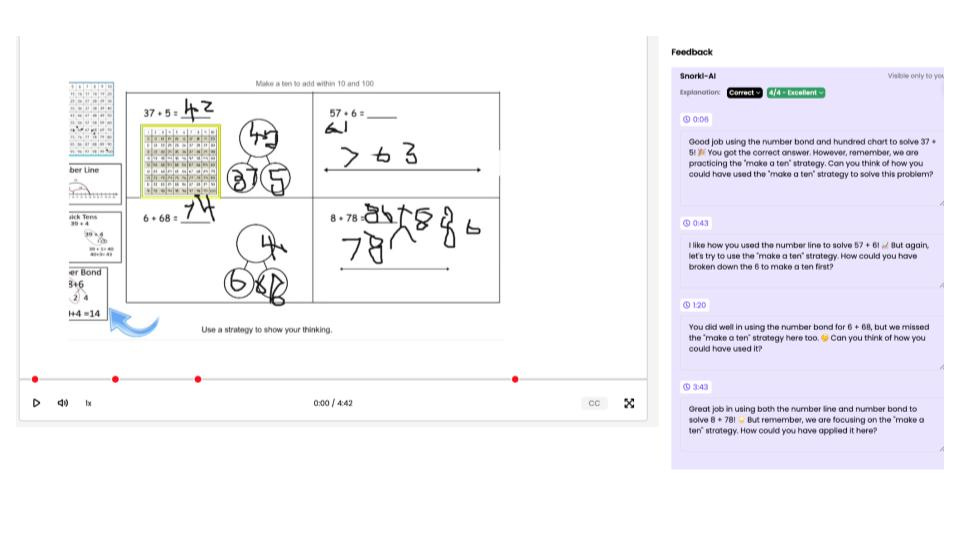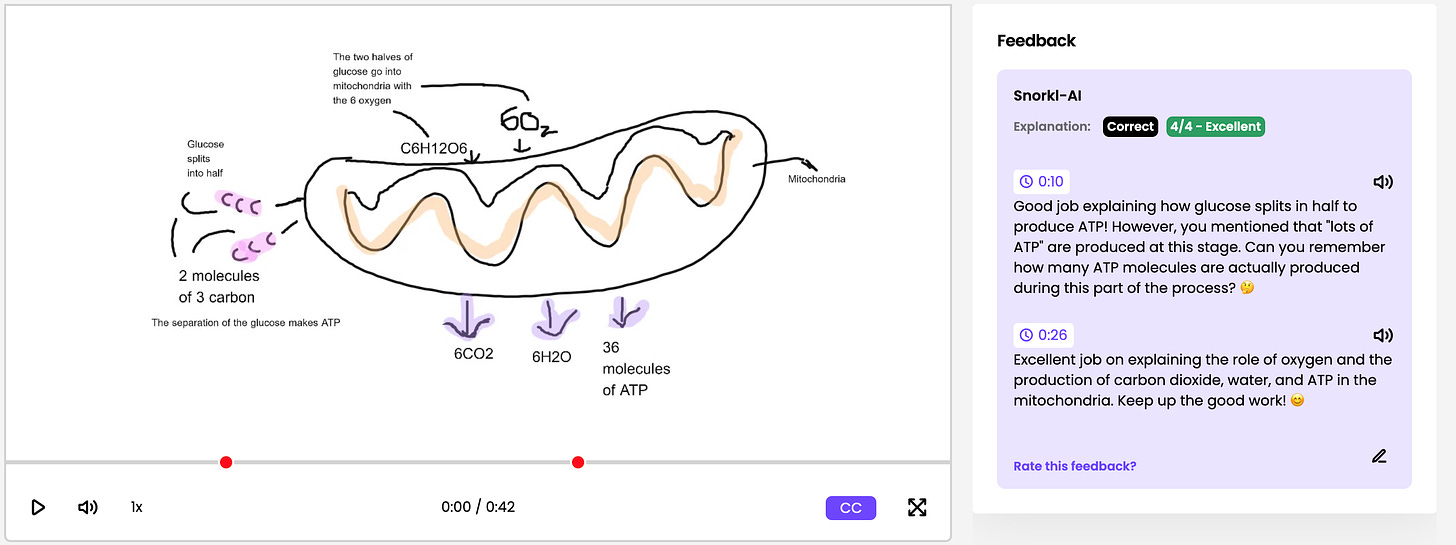Unlocking Student Learning: Two Case Studies on Snorkl AI
Making thinking visible - and audible at International School of Panama
Many AI-powered tools act as simple 'wrappers,' layering a system prompt over a Large Language Model (LLM) to guide its output, often focusing on tasks such as generating jokes or lesson plans.
These can be a low first step into AI integration but, as an instructional coach, I tend to recommend applications that provide greater added value - and are therefore also harder to replicate (and even improve) at a lower cost.
One such app is Snorkl, a digital whiteboard providing feedback to students on their markings and oral explanations. Leveraging generative AI multimodal capacities, this platform does not only offer multiple options for students to demonstrate their learning: it also makes their thinking visible, or rather audible.
Here is what two early adopters at International School of Panama had to say about their experience with this tool, and AI integration in general.
Mrs. Verna, Grade 2 Homeroom Teacher
Mrs. Verna, a Grade 2 Homeroom teacher, came to me with a touching and compelling story about one of her students. An English language learner, this child did not usually participate during text-based discussions. However, using Snorkl allowed for translanguaging strategies and allowed the student to demonstrate their understanding of the English reading in their native language. As a matter of fact, the AI indicated that their response and analysis were some of the strongest in the class.
In this instance, AI not only helped the teacher understand and support her students better, but it also boosted the student's motivation and sense of belonging, challenging assumptions about AI's impact on human relationships.
Lauding the app’s versatility, Mrs. Verna also described how she used Snorkl for math exit tickets. The platform letting teachers upload any image as a whiteboard, this was an opportunity to have students choose from a number of strategies (number charts, lines, bonds) to demonstrate their mastery of addition and substraction. While language models’ mathematical abilities are always a legitimate concern, the fact that the feedback provided by the AI is heavily grounded in the “expected answer” seems to ensure its reliability.
An unexpected benefit of using Snorkl, Mrs. Verna added, is that students proved eager to take advantage of the opportunity to resubmit and improve their work. This isn’t surprising, as psychology explains that immediate feedback and continuous improvement are key ingredients of the “flow” state that comes with gamification.
Potential uses of this FERPA and COPPA compliant technology are virtually unlimited. Yet, as Mrs. Verna concluded, AI integration is so powerful because fostering independence is also an opportunity for teachers to spend more 1:1 time with individual students. In the end, what matters first and foremost is not what the technology can do, or the appeal of its novelty, but the good pedagogical practices it enables. Especially with younger learners, there is a risk to overuse these tools, so it is crucial to be mindful of the associated screen time and to privilege “face-to-face” collaborative learning activities - unless the technological interface provides an overhwelming benefit.
Mrs. Cucalón, Grade 9 Biology Teacher
Mrs. Cucalón, a Grade 9 teacher, had another great story to share. It was the day before a Biology summative assessment, and she felt like students needed more practice - but there was no way to give them feedback on time, unless she tried that app we had been talking about.
As can be seen in the screenshot below, students were able to check their understanding by speaking on their visual representation of cellular respiration and getting feedback clarifying what they did well, or not, as well as what they could improve.
You mentioned that “lots of ATP” are produced at this stage. Can you remember how many ATP molecules are actually produced during this part of the process?
From the teacher’s perspective, Snorkl’s “Insights” open a useful window on student learning by categorizing areas of growth that can addressed through stations or other ways to adapt instruction based on automatic data collection and analysis..
Students, Mrs. Cucalón reported, found it easy to access and use the app - including drawing with laptops. They appreciated the immediate feedback, but also valued the option to talk to their teacher about their interaction with the AI, for instance if they disagreed or needed further clarification.
On her end, Mrs. Cucalón did her due diligence by double-checking the feedback received by a random sample of students, which led her to refine the context initially provided.
The more guidance you give to the AI, the better the feedback for students
Conclusion
The ease with which Snorkl was integrated into such different subjects and grade levels, as well as the extent of it benefits for both students and teachers, are quite promising - if not surprising, given the unique functionalities of this multimodal app. As expected, its best uses combined advanced technologies and direct human interactions, and kept in mind that the ensuing screen time should remain developmentally and pedagogically appropriate. As was the case with other AI experimentations, the success of these two case studies also stemmed from the fact that the teachers took the time needed to demonstrate the tool and explain the purposes of its use. Without this context, and more generally without careful teacher facilitation, students have proven quite timid in their engagement with AI-powered learning options.







